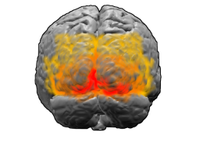
Photo from wikipedia
To optimize visual search, humans attend to objects with the expected size of the sought target relative to its surrounding scene (object-scene scale consistency). We investigate how the human brain… Click to show full abstract
To optimize visual search, humans attend to objects with the expected size of the sought target relative to its surrounding scene (object-scene scale consistency). We investigate how the human brain responds to variations in object-scene scale consistency. We use functional magnetic resonance imaging and a voxel-wise feature encoding model to estimate tuning to different object/scene properties. We find that regions involved in scene processing (transverse occipital sulcus) and spatial attention (intraparietal sulcus) have the strongest responsiveness and selectivity to object-scene scale consistency: reduced activity to mis-scaled objects (either unusually smaller or larger). The findings show how and where the brain incorporates object-scene size relationships in the processing of scenes. The response properties of these brain areas might explain why during visual search humans often miss objects that are salient but at atypical sizes relative to the surrounding scene.
Journal Title: Communications Biology
Year Published: 2021
Link to full text (if available)
Share on Social Media: Sign Up to like & get
recommendations!